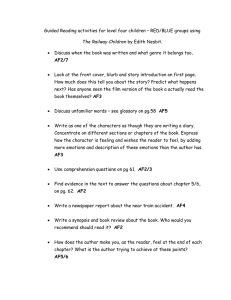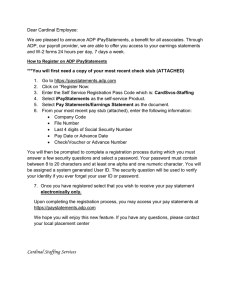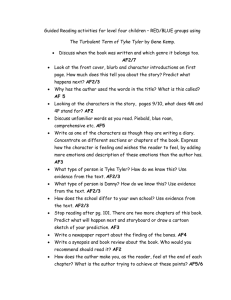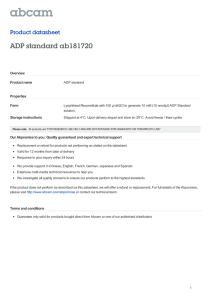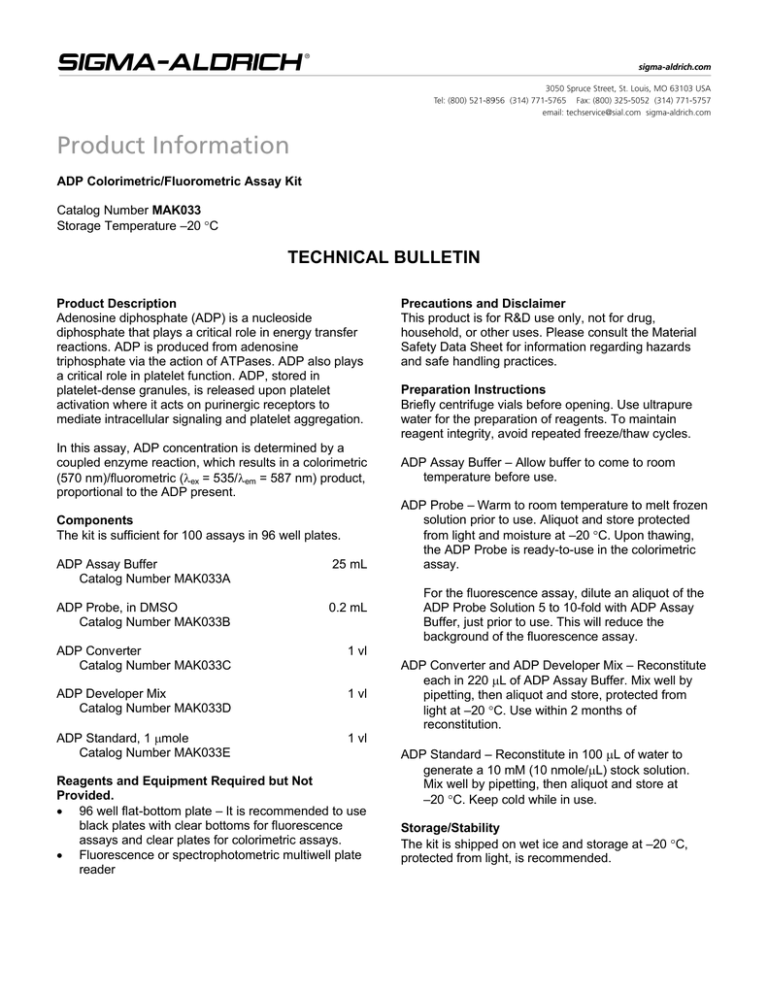
ADP Colorimetric/Fluorometric Assay Kit
Catalog Number MAK033
Storage Temperature –20 °C
TECHNICAL BULLETIN
Product Description
Adenosine diphosphate (ADP) is a nucleoside
diphosphate that plays a critical role in energy transfer
reactions. ADP is produced from adenosine
triphosphate via the action of ATPases. ADP also plays
a critical role in platelet function. ADP, stored in
platelet-dense granules, is released upon platelet
activation where it acts on purinergic receptors to
mediate intracellular signaling and platelet aggregation.
In this assay, ADP concentration is determined by a
coupled enzyme reaction, which results in a colorimetric
(570 nm)/fluorometric (λex = 535/λem = 587 nm) product,
proportional to the ADP present.
Components
The kit is sufficient for 100 assays in 96 well plates.
ADP Assay Buffer
Catalog Number MAK033A
25 mL
ADP Probe, in DMSO
Catalog Number MAK033B
0.2 mL
ADP Converter
Catalog Number MAK033C
1 vl
ADP Developer Mix
Catalog Number MAK033D
1 vl
ADP Standard, 1 µmole
Catalog Number MAK033E
1 vl
Reagents and Equipment Required but Not
Provided.
• 96 well flat-bottom plate – It is recommended to use
black plates with clear bottoms for fluorescence
assays and clear plates for colorimetric assays.
• Fluorescence or spectrophotometric multiwell plate
reader
Precautions and Disclaimer
This product is for R&D use only, not for drug,
household, or other uses. Please consult the Material
Safety Data Sheet for information regarding hazards
and safe handling practices.
Preparation Instructions
Briefly centrifuge vials before opening. Use ultrapure
water for the preparation of reagents. To maintain
reagent integrity, avoid repeated freeze/thaw cycles.
ADP Assay Buffer – Allow buffer to come to room
temperature before use.
ADP Probe – Warm to room temperature to melt frozen
solution prior to use. Aliquot and store protected
from light and moisture at –20 °C. Upon thawing,
the ADP Probe is ready-to-use in the colorimetric
assay.
For the fluorescence assay, dilute an aliquot of the
ADP Probe Solution 5 to 10-fold with ADP Assay
Buffer, just prior to use. This will reduce the
background of the fluorescence assay.
ADP Converter and ADP Developer Mix – Reconstitute
each in 220 µL of ADP Assay Buffer. Mix well by
pipetting, then aliquot and store, protected from
light at –20 °C. Use within 2 months of
reconstitution.
ADP Standard – Reconstitute in 100 µL of water to
generate a 10 mM (10 nmole/µL) stock solution.
Mix well by pipetting, then aliquot and store at
–20 °C. Keep cold while in use.
Storage/Stability
The kit is shipped on wet ice and storage at –20 °C,
protected from light, is recommended.
2
Procedure
All samples and standards should be run in duplicate.
ADP Standards for Colorimetric Detection
Dilute 10 µL of the 10 mM (10 nmole/µL) ADP Standard
Solution with 90 µL of ADP Assay Buffer to prepare a
Will dow1 mM (1 nmole/µL) standard solution. Add 0, 2,
4, 6, 8, and 10 µL of the 1 mM ADP standard solution
into a 96 well plate, generating 0 (blank), 2, 4, 6, 8, and
10 nmole/well standards. Add ADP Assay Buffer to
each well to bring the volume to 50 µL.
ADP Standards for Fluorometric Detection
Dilute 10 µL of the 10 mM (10 nmole/µL) ADP Standard
Solution with 990 µL of ADP Assay Buffer to prepare a
0.1 mM (0.1 nmole/µL) standard solution. Add 0, 2, 4,
6, 8, and 10 µL of the 1 mM ADP standard solution into
a 96 well plate, generating 0 (blank), 0.2, 0.4, 0.6, 0.8,
and 1.0 nmole/well standards. Add ADP Assay Buffer to
each well to bring the volume to 50 µL.
Sample Preparation
Liquid samples can be measured directly.
Tissue (10 mg) or cells (1 × 106) can be homogenized
in 100 µL of the ADP Assay Buffer. Centrifuge the
samples at 13,000 × g for 10 minutes to remove
insoluble material.
Bring samples to a final volume of 50 µL with ADP
Assay Buffer.
For unknown samples, it is suggested to test several
sample dilutions to ensure the readings are within the
linear range of the standard curve.
Pyruvate present in samples will generate increased
background. If pyruvate may be present in samples, it is
recommended to include a blank sample for each
sample by omitting the ADP Converter in the Reaction
Mix.
Assay Reaction
1. Set up the Master Reaction Mixes according to the
scheme in Table 1. 50 µL of the appropriate Master
Reaction Mix is required for each reaction (well).
Table 1.
Reaction Mixes
Reagent
ADP Assay Buffer
ADP Probe
ADP Converter
ADP Developer
Blank
Sample
46 µL
2 µL
–
2 µL
Samples and
Standards
44 µL
2 µL
2 µL
2 µL
2. Add 50 µL of the appropriate Reaction Mix to each
of the wells. Mix well using a horizontal shaker or
by pipetting, and incubate the reaction for
30 minutes at room temperature. Cover the plate
tightly and protect the plate from light during the
incubation.
3. For colorimetric assays, measure the absorbance
at 570 nm (A570). For fluorometric assays, measure
fluorescence intensity (λex = 535/λem = 587 nm).
3
Results
Calculations
The background for the assays is the value obtained for
the 0 (blank) ADP Standard. Correct for the background
by subtracting the 0 (blank) value from all readings.
Background values can be significant and must be
subtracted from all readings. Use the values obtained
from the appropriate ADP standards to plot a standard
curve.
Note: A new standard curve must be set up each time
the assay is run.
Subtract the sample blank value from the sample
reading to obtain the corrected measurement. Using the
corrected measurement, the amount of ADP present in
the sample may be determined from the standard
curve.
Concentration of ADP
Sa/Sv = C
Sa = Amount of ADP in unknown sample (nmole) from
standard curve
Sv = Sample volume (µL) added into the wells
C = Concentration of ADP in sample
ADP molecular weight: 427.2 g/mole
Sample Calculation
Amount of ADP (Sa) = 5.84 nmole
(from standard curve)
Sample volume (Sv) = 50 µL
Concentration of ADP in sample
5.84 nmole/50 µL = 0.1168 nmole/µL
0.1168 nmole/µL × 427.2 ng/nmole= 49.9 ng/µL
4
Troubleshooting Guide
Problem
Assay not working
Possible Cause
Suggested Solution
Cold assay buffer
Omission of step in procedure
Plate reader at incorrect wavelength
Assay Buffer must be at room temperature
Refer and follow Technical Bulletin precisely
Check filter settings of instrument
For fluorescence assays, use black plates
with clear bottoms. For colorimetric assays,
use clear plates
Use the ADP Assay Buffer
Aliquot and freeze samples if samples will be
used multiple times
Type of 96 well plate used
Samples with erratic
readings
Samples prepared in different buffer
Samples used after multiple freeze-thaw
cycles
Presence of interfering substance in the
sample
Use of old or inappropriately stored
samples
Improperly thawed components
Lower/higher
readings in samples
and standards
Use of expired kit or improperly stored
reagents
Allowing the reagents to sit for extended
times on ice
Incorrect incubation times or temperatures
Incorrect volumes used
Use of partially thawed components
Pipetting errors in preparation of standards
Pipetting errors in the Reaction Mix
Non-linear standard
curve
Air bubbles formed in well
Standard stock is at incorrect
concentration
Calculation errors
Unanticipated results
Substituting reagents from older kits/lots
Samples measured at incorrect
wavelength
Samples contain interfering substances
Sample readings above/below the linear
range
If possible, dilute sample further
Use fresh samples and store correctly until
use
Thaw all components completely and mix
gently before use
Check the expiration date and store the
components appropriately
Prepare fresh Master Reaction Mix before
each use
Refer to Technical Bulletin and verify correct
incubation times and temperatures
Use calibrated pipettes and aliquot correctly
Thaw and resuspend all components before
preparing the reaction mix
Avoid pipetting small volumes
Prepare a Master Reaction Mix whenever
possible
Pipette gently against the wall of the plate
well
Refer to the standard dilution instructions in
the Technical Bulletin
Recheck calculations after referring to
Technical Bulletin
Use fresh components from the same kit
Check the equipment and filter settings
If possible, dilute sample further
Concentrate or dilute samples so readings
are in the linear range
LS,MAM 09/12-1
2012 Sigma-Aldrich Co. LLC. All rights reserved. SIGMA-ALDRICH is a trademark of Sigma-Aldrich Co. LLC, registered i the US and other
countries. Sigma brand products are sold through Sigma-Aldrich, Inc. Purchaser must determine the suitability of the product(s) for their
particular use. Additional terms and conditions may apply. Please see product information on the Sigma-Aldrich website at
www.sigmaaldrich.com and/or on the reverse side of the invoice or packing slip.

